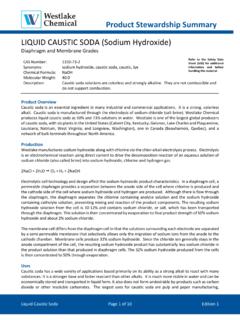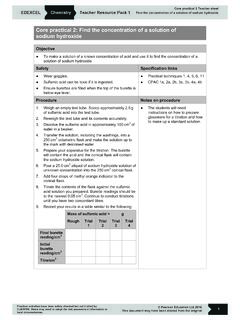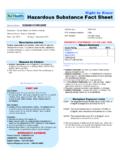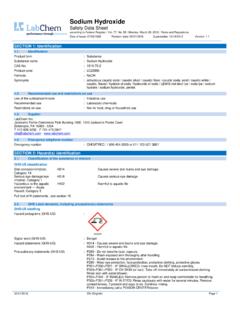Transcription of STANDARDIZATION OF A SODIUM HYDROXIDE SOLUTION …
1 139 OBJECTIVE The objective of this experiment will be the STANDARDIZATION of SODIUM HYDROXIDE using potassium hydrogen phthalate by the titration method. EQUIPMENT AND CHEMICALS SODIUM HYDROXIDE Phenolphthalein SOLUTION KHP 500 ml polyethylene bottle 10 ml graduated cylinder 50 ml buret 250 ml Erlenmeyer flask 50 ml graduated cylinder 50 ml beaker DISCUSSION In order to determine the concentration of a SOLUTION , there must be something to compare it against (benchmark). This benchmark is referred to as a standard. SODIUM HYDROXIDE (a base) is typically used as a standard to determine the concentration of acids. When an acid and base react, they form salt and water. watersaltbaseacid+ + In a titration the volume of a SOLUTION added to a reaction is measured using a buret. A buret is a long tube with a valve (stopcock) at one end at one end that can be used to control the flow.
2 Burets are typically calibrated in milliliters. The acid and base are reacted together until one of the two is completely reacted. That point is called the endpoint that is neutral. If any additional acid or base is added, the SOLUTION will then become acidic or basic depending on which was added in excess. To visually determine the endpoint, an indicator is added to the reaction. An indicator is a chemical that changes colors at a particular pH. When just a tiny excess of the acid or base is added beyond the completion of the reaction, the indicator changes color. The amount added from the buret at this point is called the endpoint. In order to use a standardized SOLUTION , the SOLUTION must be prepared. After preparation of the standard, the exact concentration of the standard SOLUTION must be determined. In this experiment, a SODIUM HYDROXIDE SOLUTION (NaOH) will be prepared.
3 In order to standardize the SODIUM HYDROXIDE SOLUTION , there must be a substance used to standardize against. This substance will be potassium hydrogen phthalate (KHP). KHP is an organic acid that is solid and thus, easily weighed. STANDARDIZATION OF A SODIUM HYDROXIDE SOLUTIONEXPERIMENT 14 140 Using basic stoichiometry, the moles of NaOH in the SOLUTION can be determined from the moles of KHP added to the reaction. OHKNaPNaOHKHP2+ + Note the molar relationship. For every one mole of KHP, it would take one mole of NaOH to react it completely. Since we weigh out a particular mass of KHP, we can easily calculate the moles of KHP we will use as the standard. The molecular mass of KHP is amu. Since for every one mole of KHP used it takes one mole of NaOH to react with it, if the moles of KHP is known, the moles of NaOH is known.
4 NaOHofmolesKHPofmoles= In the titration, the NaOH is added drop by drop using the buret. The buret indicates how much NaOH is being added to the KHP. At the point where all the KHP has been reacted (endpoint) any additional NaOH will turn the SOLUTION basic. The indicator, phenolphthalein, turns the SOLUTION from clear to pink in a basic SOLUTION . This is called the endpoint. The volume of NaOH added to the KHP is read off the buret in milliliters (endpoint) and converted to liters (liters = ml / 1000). The concentration (molarity) of the SODIUM HYDROXIDE SOLUTION can now be determined. NaOHoflitersNaOHofmolesNaOHofmolarity= This standardized NaOH SOLUTION can now be used as a standard for the determination of acid concentrations. Example: grams of KHP is titrated with 40 ml of the unknown NaOH SOLUTION . What is the molarity of the NaOH SOLUTION ?
5 SOLUTION : PROCEDURES PREPARATION OF NaOH SOLUTION 1. Using a 10 ml graduated cylinder, add 10 ml of 5M NaOH into a clean 500 ml polyethylene bottle. (caution: NaOH is extremely caustic and can cause burns. Avoid contact with skin. Rinse with water in some gets on you skin) 2. Add 500 ml of boiled DI water. The boiling removes nay dissolved CO2. 3. Cap the bottle, label and shake. PREPARATION OF BURET 4. Clean a 50 ml buret and rinse with DI water. A clean buret will have no droplets clinging to inside of the glass. 5. Rinse the buret with two 5 ml portions of the your labeled NaOH SOLUTION . Make sure you drain the NaOH SOLUTION through the tip of the buret and dispose of the used NaOH SOLUTION into the 250 ml waste beaker. 6. Using a funnel, fill the buret with the NaOH SOLUTION . Make sure that the tip is also filled and there are no air bubbles in the tip.
6 The instructor will demonstrate how to remove bubbles. 7. Slowly drain the NaOH out of the buret until the buret reads approximately ml. Read from the bottom of the meniscus. It is sometimes helpful to hold a piece of paper with a black line behind the buret and line it up with the meniscus. 142 PREPARATION OF KHP STANDARD 8. Weigh to the nearest milligram to grams of dried KHP (potassium hydrogen phthalate) in a clean 250 ml flask. 9. Add 50 ml of DI water to the flask. 10. Add two drops of phenolphthalein indicator. STANDARDIZATION OF NaOH 11. Place a white background underneath the flask with the KHP SOLUTION . 12. Slowly add with constant swirling the NaOH drop-wise to the KHP SOLUTION . 13. Continue adding NaOH drop wise with constant swirling to the KHP SOLUTION until the KHP SOLUTION turns a faint shade of pink that remains for 30 seconds.
7 This is called your endpoint. 14. Calculate the molarity in moles/liter of the NaOH SOLUTION . 15. Repeat steps 8 14 two additional times. 16. Calculate the average molarity of the three titrations. 143 Name _____ Date _____ Section _____ STANDARDIZATION OF NaOH REPORT SHEET REPORT SHEET EXPERIMENT 14 Preparation of the primary KHP SOLUTION Trial 1 Trial 2 Trial 3 Mass of KHP Formula mass of KHP ( g/moles)
8 Moles of KHP (mass of KHP / formula mass KHP) Titration of KHP Final buret reading in ml Initial buret reading in ml Volume of NaOH added (final initial) in ml Volume of NaOH added in liters (ml / 1000) Molarity of NaOH (moles KHP / liters NaOH) Average Molarity of NaOH









